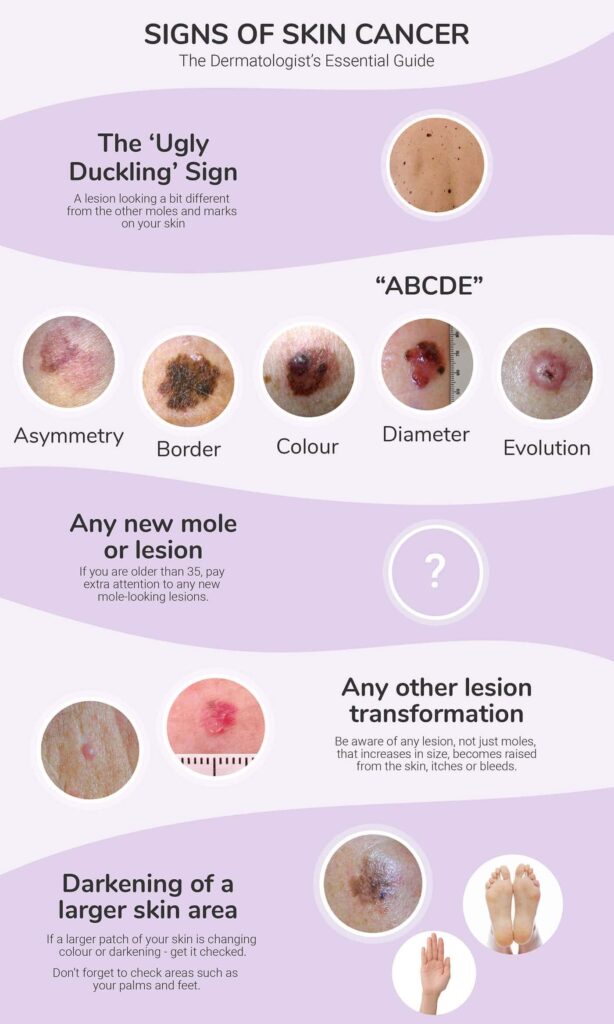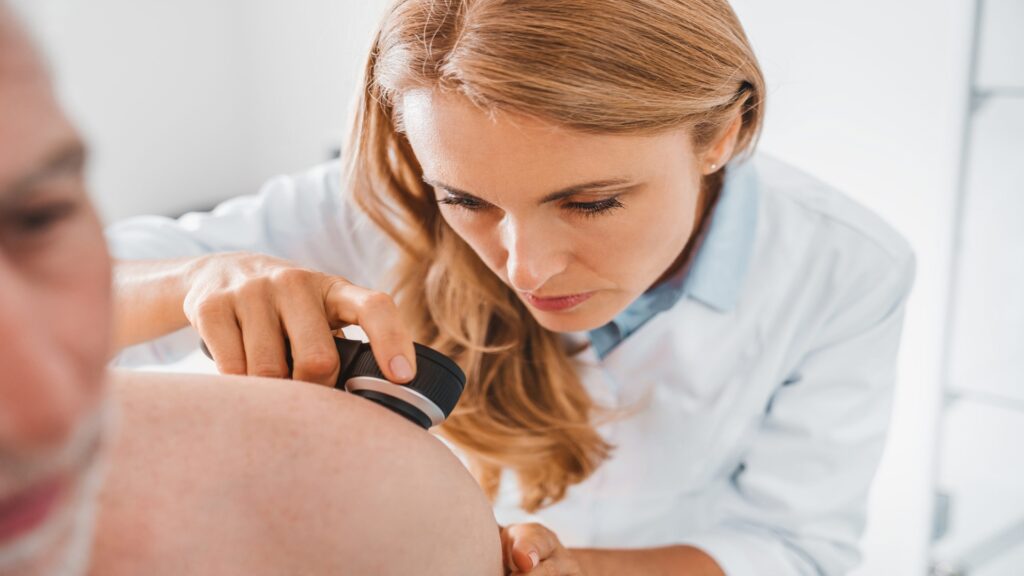Introduction
In this article, we will delve into the critical topic of skin cancer and its warning signs. Our aim is to equip you with valuable knowledge that can help you identify potential signs of skin cancer at an early stage. Skin cancer is a serious health concern, and being aware of its warning signs can play a crucial role in its detection and treatment. Let’s explore the various indicators you should be mindful of and empower you to take control of your skin health.
Foods that affect your Brain and reduce your intelligence | Breast cancer patients can choose a smaller surgery for cure
Types of Skin Cancer
Before we discuss the warning signs, let’s familiarize ourselves with the different types of skin cancer. The three most common types are:
- Basal Cell Carcinoma (BCC): This is the most prevalent type of skin cancer. BCC often appears as a pearly or waxy bump and can develop anywhere on the body, but it is commonly found on areas frequently exposed to the sun, such as the face, neck, and hands.
- Squamous Cell Carcinoma (SCC): SCC typically manifests as a red, scaly patch or sore that fails to heal. Like BCC, it is commonly found on sun-exposed areas but can also occur on other parts of the body.
- Melanoma: Although less common than BCC and SCC, melanoma is the most aggressive form of skin cancer. It often begins as an irregularly shaped mole or lesion with uneven borders and may exhibit variations in color.
Identifying Warning Signs
Early detection of skin cancer greatly increases the chances of successful treatment. Therefore, it is crucial to be vigilant and recognize the warning signs that may indicate the presence of skin cancer. Here are some key indicators to watch out for:

1. Changes in Moles or Birthmarks
Regularly examining your moles and birthmarks can be a proactive step in detecting skin cancer. Look for the following changes using the ABCDE rule:
- Asymmetry: One half of the mole does not match the other half.
- Border: The edges of the mole are irregular, blurred, or poorly defined.
- Color: The mole exhibits variations in color, including shades of brown, black, blue, or red.
- Diameter: The mole is larger than 6 millimeters in diameter.
- Evolving: The mole changes in size, shape, or color over time.
2. New Growths or Sores
Pay attention to any new growths, sores, or lesions that appear on your skin and do not heal within a reasonable timeframe. These can be potential indicators of skin cancer.
3. Changes in Texture and Sensation
Skin cancer may cause changes in the texture of your skin. Be aware of rough, scaly, or crusty patches that persist or worsen. Additionally, if a mole or lesion becomes itchy, tender, or painful, it is essential to consult a healthcare professional.
4. Spots or Bumps
Keep an eye out for spots or bumps on your skin that seem different from your usual skin texture. These may include shiny, pink, red, or translucent bumps. Any unusual growths should be evaluated by a medical expert.
Seeking Medical Attention
If you notice any of the aforementioned warning signs or have concerns about changes in your skin, it is imperative to seek professional medical advice promptly. A dermatologist, who specializes in diagnosing and treating skin conditions, can provide a thorough examination and determine the appropriate course of action.
Prevention and Protection
While being aware of warning signs is crucial, taking preventive measures can significantly reduce your risk of developing skin cancer. Here are some essential strategies to protect your skin:
- Sun Protection: Limit your sun exposure, especially during peak hours when the sun’s rays are the strongest. Wear protective clothing such as wide-brimmed hats, long-sleeved shirts, and pants. Don’t forget to apply a broad-spectrum sunscreen with an SPF of 30 or higher to exposed skin, including your face, neck, and hands. Remember to reapply sunscreen every two hours or more frequently if you’re swimming or sweating.
- Seek Shade: When outdoors, seek shade under umbrellas, trees, or other forms of shelter. This reduces direct exposure to harmful UV rays, decreasing your risk of developing skin cancer.
- Avoid Tanning Beds: Tanning beds emit harmful UV radiation, which can significantly increase the risk of skin cancer. Opt for safer alternatives like self-tanning products if you desire a sun-kissed appearance.
- Perform Self-Examinations: Conduct regular self-examinations of your skin to identify any changes or new growths. By becoming familiar with your skin’s normal appearance, you’ll be better equipped to recognize any suspicious alterations.
- Protect Your Eyes: Don’t overlook the importance of protecting your eyes from harmful UV rays. Wear sunglasses that provide 100% UV protection to shield your eyes and the delicate skin around them.
- Stay Hydrated: Keeping your skin well-hydrated promotes overall skin health and resilience. Drink an adequate amount of water daily to maintain hydration from within.
- Healthy Lifestyle: Maintain a healthy lifestyle by consuming a balanced diet rich in fruits, vegetables, and antioxidants. Regular exercise and stress management techniques can also contribute to optimal skin health.
Remember, while these preventive measures can significantly reduce your risk of developing skin cancer, it is crucial to remain vigilant and attentive to any changes in your skin. Early detection and timely medical intervention are key to successful outcomes.
Conclusion
Skin cancer is a serious health concern, but by being aware of the warning signs and taking proactive measures, you can significantly reduce your risk. Regularly examine your skin, paying attention to changes in moles, the appearance of new growths or sores, and alterations in texture or sensation. If you notice any concerning signs, consult a dermatologist promptly for a professional evaluation.
Remember, prevention is key. Take steps to protect your skin from harmful UV radiation, such as wearing protective clothing, seeking shade, and applying sunscreen. Avoid tanning beds and prioritize a healthy lifestyle that includes a balanced diet, regular exercise, and stress management.
By prioritizing your skin health and being proactive in its care, you are taking an important step towards maintaining overall well-being. Stay informed, stay protected, and prioritize regular skin checks for a lifetime of healthy skin.

